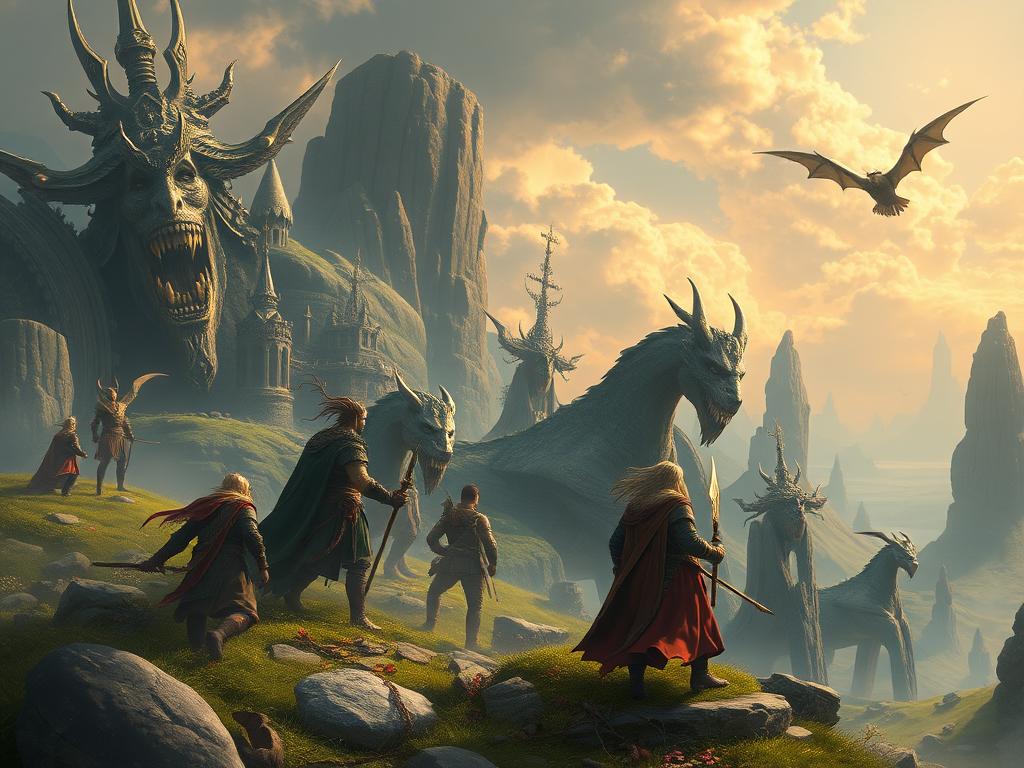

In the vast tapestry of gaming, epic adventures await those who dare to embark on journeys through diverse realms. As you delve into these captivating worlds, storytelling in games unfolds with every quest and character interaction. Narrative design serves as the cornerstone of these adventures, weaving intricate gaming narratives that captivate and immerse. Interactive storytelling allows you to influence video game plots, making each decision a thread in the tapestry of character development in games. The allure of role-playing games lies in their ability to offer immersive gaming experiences where narrative-driven games shine with their deep story arcs in gaming. Through innovative gaming storytelling techniques, these tales evoke an emotional connection, drawing you deeper into the game lore. Branching storylines and story choices in games mean your path is ever-evolving, with plot twists in video games challenging your expectations. World-building in games transforms digital landscapes into vibrant stages for storytelling innovation in gaming, where the game storytelling impact reverberates through your every choice. As you engage in narrative pacing in games, the analysis of these story-rich games reveals a world of epic adventures, waiting just beyond the next horizon. Through meticulous storytelling elements in gaming, you find yourself as both player and protagonist in these unforgettable interactive narrative experiences.

What makes storytelling in games such a transformative force? In the world of gaming, the narrative unfurls as more than just a backdrop—it becomes the heartbeat of your adventure. Through thoughtful narrative design, you're drawn into gaming narratives that offer more than action sequences. These tales engage your mind and heart, setting the stage for immersive gaming experiences where interactive storytelling thrives. Video game plots are no longer linear pathways but rich tapestries of possibility.
Your role within these narratives transitions from mere spectator to active participant. With each storyline twist and character development in games, your choices carry weight, affecting the outcome of narrative-driven games. This depth creates an unparalleled emotional connection in games, where your journey unfolds uniquely with every playthrough. As you navigate plot-driven gameplay, the storytelling elements in gaming provoke reflection and decision-making that resonate long after you’ve turned off your console or closed your laptop.
Delving into role-playing games, you're met with world-building in games that invites exploration and discovery. Within these realms, game lore and storytelling mechanics enrich the player experience, offering narrative immersion and branching storylines that engage your imagination. The dynamic story arcs in gaming not only craft a compelling setting but also challenge you to think critically about your choices.
The innovation doesn't stop there. Game story development continues to evolve, using storytelling techniques designed to elevate player engagement in narratives. This evolution yields interactive narrative experiences where plot twists in video games defy expectations, layered with narrative pacing in games that maintains a gripping, steady rhythm. With such advancements, storytelling innovation in gaming realizes its full potential.
Analyzing gaming story impact, it's clear the power of storytelling lies in its capacity to forge deep connections between you and the digital world. The intertwining of story choices in games and character-driven gameplay ensures that each narrative unfolds as uniquely as its player, turning every epic quest into a personal journey. This synergy between player and plot beckons you to explore the limitless possibilities that await within story-rich games.

In the realm of gaming, character development forms a vital bridge between story and player. As you navigate through narrative-driven games, storytelling in games crafts characters that resonate deeply with you. From their personal growth to their intricately woven backstories, these characters are more than digital avatars; they serve as conduits for emotional connection in games, heightening the immersive gaming experience and reinforcing player engagement in narratives.
Consider the impressive character-driven gameplay of The Witcher series, which exemplifies storytelling innovation in gaming. A closer look at CD Projekt Red's approach reveals how Geralt of Rivia evolves through compelling story arcs. These meticulously crafted video game plots intertwine with your choices, allowing interactive storytelling to flourish. It’s a striking example of narrative design that resonates with players globally, strengthening your bond with the protagonist through intricate game story development.
Communicating a sense of narrative immersion, characters in role-playing games often become a palette for player expression. This interactivity stems from branching storylines and story choices in games that adapt with each decision you make. In turn, plot-driven gameplay is enriched by storytelling elements in gaming making each character's journey uniquely personal. This dynamic interaction transforms mere gameplay into an interactive narrative experience compelling you to invest in your character's fate.
Through comprehensive world-building in games, character development enhances gaming narratives by embedding you into the game lore. By scrutinizing these storytelling mechanics, you're enveloped in the gaming storytelling techniques that balance narrative pacing in games. This careful orchestration ensures that character evolution syncs harmoniously with player experiences, transforming every narrative from simple plot twists in video games to meaningful, story-rich adventures that leave a lasting impression.

One of the challenges in creating compelling virtual worlds is achieving a seamless blend of storytelling and environmental detail. Without effective world-building, gaming narratives may lack depth, resulting in diminished player engagement. This issue can be addressed by incorporating storytelling mechanics that intertwine game lore with interactive elements. By crafting environments rich with history and context, game developers can foster immersive gaming experiences where every corner of the world tells a story and maintains a strong narrative immersion.
The key to resolving this is a keen emphasis on detailed narrative design and storytelling innovation in gaming. Through meticulous narrative pacing and storytelling elements in gaming, environments become vibrant character players interact with. In role-playing games, dynamic world-building in games can guide story arcs, while plot-driven gameplay encourages exploration and discovery. This fosters an emotional connection in games, turning them into narrative-driven adventures that invite players to delve deeper into the intricacies of story-rich games.

In the landscape of modern gaming, narrative design is continually evolving to captivate and engage players. While many believe that straightforward storytelling suffices in gaming, there’s a strong case for innovative narrative techniques that push the boundaries of gaming narratives. These techniques, such as interactive storytelling and branching storylines, enhance video game plots by allowing you to influence the story’s direction, thereby creating a unique interactive narrative experience.
Traditionally, character development in games has followed linear paths. However, the rise of character-driven gameplay revolutionizes this aspect by offering game story development that responds dynamically to your choices. This method fosters an emotional connection in games, where player engagement is heightened as you witness direct consequences unfold through storytelling elements in gaming. These adaptive narratives redefine narrative immersion, inviting you to invest more deeply in the game world.
Plot-driven gameplay, which once reigned supreme in narrative-driven games, now coexists with more fluid story arcs in gaming. Through the incorporation of storytelling innovations such as game lore and world-building in games, developers cultivate immersive environments that envelop you in story-rich games. These environments engage you through storytelling mechanics that present plot twists in video games, challenging your expectations and maintaining narrative pacing in games that captivate from start to finish.
Given the complexities of modern gaming storytelling, gaming story analysis highlights the benefits of embracing these innovative techniques. Replacing conventional narratives with complex, layered gaming storytelling techniques enhances the game storytelling impact. By blending these methodologies, gaming narratives transcend beyond entertainment, becoming transformative experiences that resonate and leave a lasting impact.

In the realm of gaming, player choice has become a cornerstone of immersive experiences, allowing you to shape not just the narrative but the entire gameplay itself. Through advanced narrative design, story choices in games become pivotal, weaving personal paths that enhance narrative immersion. You become not just a player but an integral part of gaming narratives, making interactive storytelling a powerful tool in crafting memorable gaming experiences.
Role-playing games particularly excel in this arena, with branching storylines that offer a multitude of outcomes based on your decisions. Character-driven gameplay ensures that your choices affect character development in games and plot-driven gameplay alike, creating a profound emotional connection as you guide your avatar through complex story arcs in gaming. These impactful decisions transform video game plots, making each journey uniquely your own.
In the next few years, player choice is likely to redefine the very fabric of video game narratives. Future advancements in game storytelling techniques and storytelling mechanics will usher in a new era of storytelling innovation in gaming. By allowing more dynamic interaction within story-rich games, the impact of your decisions will become increasingly significant, further blurring the line between reality and virtual world-building in games.
As game story development progresses, the integration of player choice into plot twists in video games will lead to highly customized interactive narrative experiences. The game storytelling impact will be intensified as players discover that their decisions not only affect their immediate environment but resonate throughout the entire gaming world. This evolution promises richer, more engaging narratives that continue to captivate and challenge you at every turn.

In the dynamic world of gaming, the emotional engagement players experience is an evolving frontier. Through sophisticated narrative design, gaming narratives are crafted to evoke feelings that resonate on a deeply personal level. The art of storytelling in games draws from character-driven gameplay, where you form emotional connections with characters whose growth reflects your own decisions, creating profoundly immersive gaming experiences.
The current state of emotional engagement in game stories shows a discernible trend toward deeper narrative immersion. As role-playing games and narrative-driven games evolve, developers are increasingly prioritizing emotional connection in games. Interactive storytelling techniques leverage storytelling elements in gaming to create story arcs that mirror real-life experiences, enhancing player engagement in narratives through carefully crafted plot-driven gameplay.
Analyzing these trends, it's clear that the future of game story development will prioritize narratives infused with emotional depth. By incorporating game lore and innovative storytelling mechanics, game storytelling impact is magnified. The emotional connections forged between you and the game's world are becoming integral to story-rich games, where narrative pacing ensures every moment is laden with meaning, making these interactive narrative experiences unforgettable.
Get free resources, tips & tricks, exclusive news, and special offers by joining the Cryptonite Newsletter.